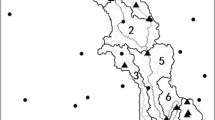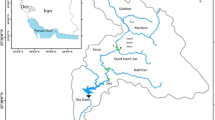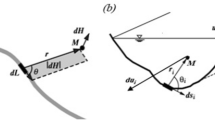Abstract
In this study, we proposed an improved streamflow regionalization technique to avoid the systematic errors associated with the existing techniques, such as the simple Multiple Linear Regression (MLR) and Stepwise Regression (SWR). We hypothesized that the proposed Constrained Hydrologic Regression Technique (CHRT) would be more robust, consistent, and accurate than the MLR and SWR. Cross validation was also conducted in order to verify how the proposed CHRT was a feasible tool, along with the SWR and Principal Component Analysis (PCA) based regression. The predictive performances of the proposed method were evaluated using the Leave One Out Cross Validation (LOOCV) procedure and other evaluation criteria, such as the Nash-Sutcliff coefficient (NASH), Root Mean Square Error (RMSE), and the adjusted coefficient of determination (R 2 adj ). The results indicated that for the CHRT, SWR, and PCA, the average NASH values were 75, 58.16, and 65.23 respectively based on performance measures. Therefore, it is noted that the CHRT is a significant method for prediction of the Flow Duration Curve (FDC) as compared to contenders. Hence, the CHRT could be a more promising tool for the hydrological prediction at ungauged basins.
Similar content being viewed by others
References
Acharya, A. and Ryu, J. (2014). “Simple method for streamflow disaggregation.” ASCE Journal of Hydrologic Engineering, Vol. 19, No. 3, pp. 509–519, DOI: 10.1061/(ASCE)HE.1943-5584.0000818.
Andreassian, V., Perrin, C., Michel, C., Usart-Sanchez, I., and Lavabre, J. (2001). “Impact of imperfect rainfall knowledge on the efficiency and the parameters of watershed models.” Journal of Hydrology, Vol. 250, Nos. 1, pp. 206–223, DOI: 10.1016/S0022-1694(01)00437-1.
Archfield, S. A., Vogel, R. M., and Brandt, S. L. (2007). “Estimation of flow duration curves at ungauged sites in southern England.” Proceedings of the American Society of Civil Engineers World Water and Environmental Resources Congress, Tampa, FL.
Arditi, R. (1989). “Avoiding fallacious significance tests in stepwise regression: A Monte Carlo method applied to a meteorological theory for the Canadian lynx cycle.” International Journal of Biometeorology, Vol. 33, No. 1, pp. 24–26, DOI: 10.1007/BF01045893.
Castellarin, A., Camorani, G., and Brath, A. (2007). “Predicting annual and long-term flow-duration curves in ungauged basins.” Advances in Water Resources, Vol. 30, No. 4, pp. 937–953, DOI: 10.1016/j.advwatres.2006.08.006.
Castellarin, A., Galeati, G., Brandimarte, L., Montanari, A., and Brath, A. (2004). “Regional flow-duration curves: reliability for ungauged basins.” Advances in Water Resources, Vol. 27, No. 10, pp. 953–965, DOI: 10.1016/j.advwatres.2004.08.005.
Di Prinzio, M., Castellarin, A., and Toth, E. (2011). “Data-driven catchment classification: Application to the PUB problem.” Hydrology and Earth System Sciences, Vol. 15, No. 6, pp. 1921–1935, DOI: 10.5194/hess-15-1921-2011.
Farmer, F. W. and Vogel, R. M. (2013). “Performance-weighted methods for estimating monthly stream flow at ungauged site.” Journal of Hydrology, Vol. 477, No. 16, pp. 240–250, DOI: 10.1016/j.jhydrol.2012.11.032.
Ganora, D., Claps, P., Laio, F., and Viglione, A. (2009). “An approach to estimate non-parametric flow duration curves in ungauged basins.” Water Resource Research, Vol. 45, No. 10, W10418, DOI: 10.1029/2008WR007472.
Gatu, C., and Kontoghiorghes, E. J. (2012). “Branch and bound algorithms for computing the best subset regression models.” Journal of Computational and Graphical Statistics, Vol. 15, No. 1, pp. 139–156, DOI: 10.1198/106186006X100290.
Helsel, D. R. and Hirsch, R. M. (2002). “Statistical method in water resources.” U.S Geological Survey Publication, USA. (http://water.usgs.gov/pubs/twri/twri4a3/)
Hoerl, A. E. and Kennard, R. W. (2000). “Ridge regression: Biased estimation for nonorthogonal problems.” Technometrics, Vol. 12, No. 1, pp. 55–67, DOI: 10.1080/00401706.1970.10488634.
Kim, S. and Lee, K. (2010). “Regional low flow frequency analysis using Bayesian regression and prediction at ungauged catchment in Korea.” KSCE Journal of Civil Engineering, Vol. 14, No. 1, pp. 87–98, DOI: 10.1007/s12205-010-0087-7.
Konno, H. and Yamamoto, R. (2009). “Choosing the best set of variables in regression analysis using integer programming.” Journal of Global Optimization, Vol. 44, No. 2, pp. 272–282, DOI: 10.1007/s10898-008-9323-9.
Kroll, C. N. and Song, P. (2013). “Impact of multicollinearity on small sample hydrologic regression models.” Water Resource Research, Vol. 49, No. 6, pp. 3756–3769, DOI: 10.1002/wrcr.20315.
Laaha, G. and Blöschl, G. (2007). “A national low flow estimation procedure for Austria.” Hydrological Science Journal, Vol. 52, No. 4, pp. 625–644, DOI: 10.1623/hysj.52.4.625.
Ley, R., Casper, M. D., Hellenbrand, H., and Merz, R. (2011). “Catchment classification by runoff behavior with Self-Organizing Maps (SOM).” Hydrology and Earth System Sciences, Vol. 15, No. 9, pp. 2947–296, DOI: 10.5194/hessd-8-3047-2011.
McIntyre, N., Lee, H., and Wheater, H. (2005). “Ensemble prediction of runoff in ungauged catchments.” Water Resource Research, Vol. 41, No. 12, W12434, DOI: 10.1029/2005WR004289.
Moriasi, D. N, Arnold, J. G., Van Liew, M.W, Bingner, R. L, Harmel, R. D., and Veith, T. L. (2007). “Model evaluation guidelines for systematic quantification of accuracy in watershed simulations.” Transaction of the American Society of Agricultural and Biological Engineers, Vol. 50, No. 3, pp. 885–900.
Nobert, J., Ndayizeye, J., and Mkhandi, S. (2011). “Regional flow duration estimation and its application in assessing low flow characteristics for ungauged catchment. a case study of Rwegura catchment-Burundi.” Nile Basin Water Science and Engineering Journal, Vol. 4, No. 1, pp. 14–23.
Opere, A. O. and Mkhandi, W. S. P. (2009). “Homogeneity testing for peak discharge in catchments in the equatorial Nile basins.” Journal of Meteorology and Related Sciences, Vol. 3, No. 3, pp. 13–20.
Ryu, J. H., Svoboda, M. D., Lenter, J. D., Tadesse, T., and Knutson, C. L. (2010). “Potential extents for ENSO-driven hydrologic drought forecasts in the United States.” Climate Change, Vol. 101, No. 3, pp. 575–597, DOI: 10.1007/s10584-009-9705-0.
Sauquet, E., and Catalogne, C. (2011). “Comparison of catchment grouping methods for flow duration curve estimation at ungauged sites in France.” Hydrology and Earth System Sciences, Vol. 15, No. 8, pp. 2421–243, DOI: 10.5194/hessd-8-3233-2011.
Shu, C. and Ouarda, T. B. M. J. (2012). “Improved method for daily streamflow estimate at ungauged sites.” Water Resource Research, Vol. 48, No. 2, W02523, DOI: 10.1029/2011WR011501.
Sine, A. and Ayalew, S. (2004). “Identification and delineation of hydrological homogeneous regions-The case study of Blue Nile River Basin.” FWU, Vol. 4, Lake Abaya Research Symposium 2004-Proceedings.
Tootle, G., Singh, A., Piechota, T., and Farnham, I. (2007). “Long leadtime forecasting of U.S. streamflow using partial least squares regression.” ASCE Journal of Hydrologic Engineering, Vol. 12, No. 5, pp. 442–451, DOI: 10.1061/(ASCE)1084-0699(2007)12:5(442).
Waseem, M., Ajmal, M., and Kim, T. W. (2015). “Development of a new composite drought index for multivariate drought assessment.” Journal of Hydrology, Vol. 527, August, pp. 30–37, DOI: 10.1016/j.jhydrol.2015.04.044.
Yusuf, M. M. (2008). “Prediction of daily flow duration curve and streamflow for ungauged catchments using regional flow duration curve.” Hydrological Science Journal, Vol. 53, No. 4, pp. 706–724, DOI: 10.1623/hysj.53.4.706.
Author information
Authors and Affiliations
Corresponding author
Rights and permissions
About this article
Cite this article
Waseem, M., Ajmal, M. & Kim, TW. Improving the flow duration curve predictability at ungauged sites using a constrained hydrologic regression technique. KSCE J Civ Eng 20, 3012–3021 (2016). https://doi.org/10.1007/s12205-016-0038-z
Received:
Revised:
Accepted:
Published:
Issue Date:
DOI: https://doi.org/10.1007/s12205-016-0038-z




